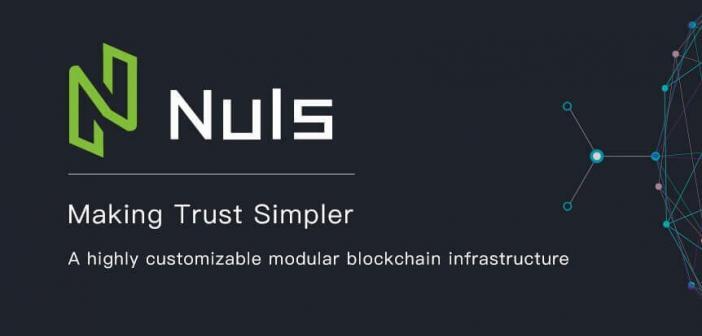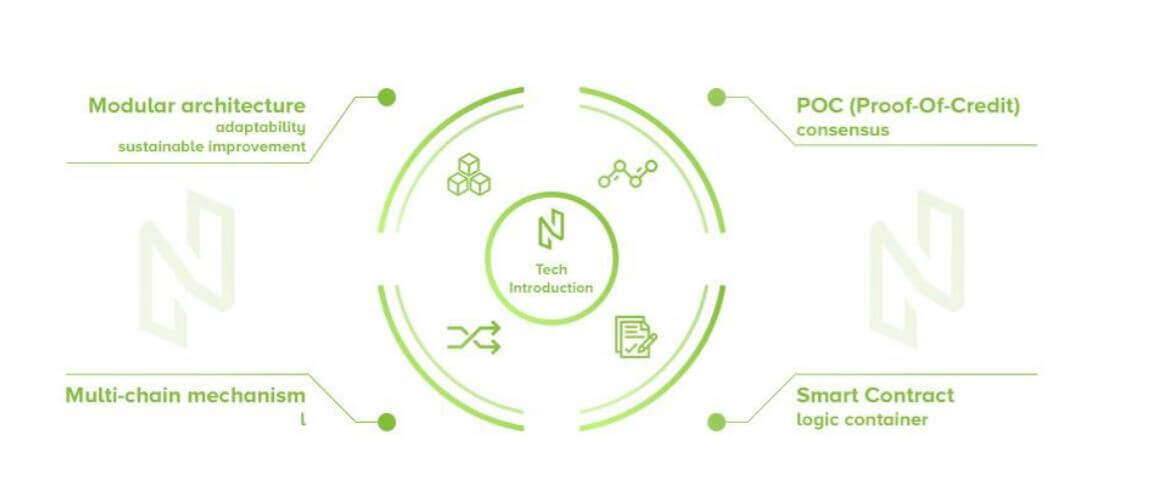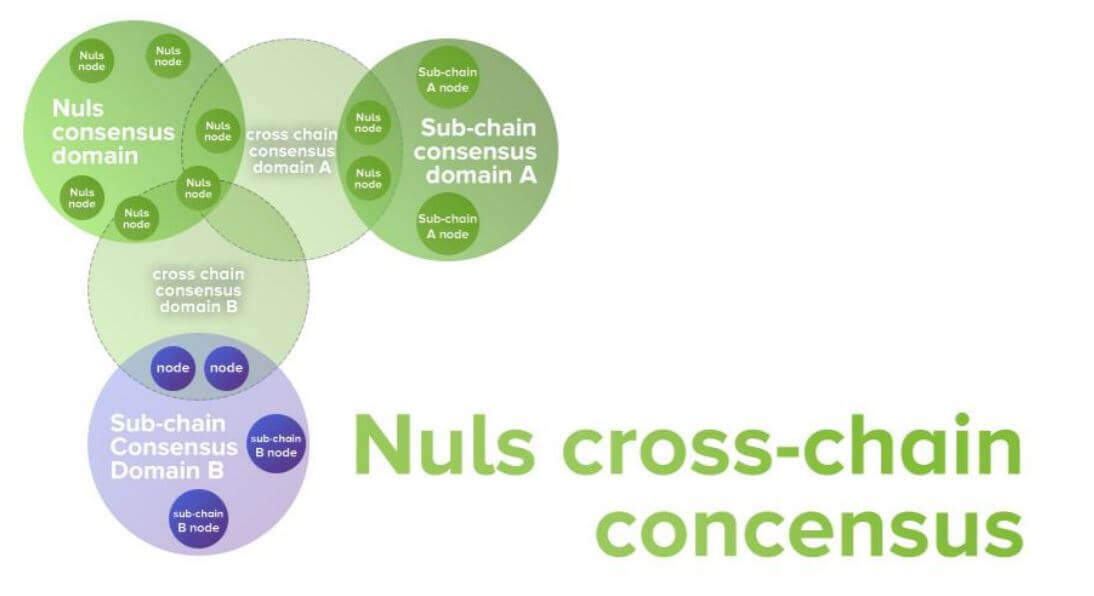Learn how blockchain truly works, master key definitions, and uncover what makes smart contracts so "smart." Dive into the fundamentals, gain valuable insights, and start your blockchain journey today!

- Guides
Aviv Lichtigstein
- on June 28, 2018
Beginners Guide: What is Nuls? The Business Blockchain
Nuls blockchain aims at providing business entities with a platform for creating and deploying their decentralized applications to solve the problems that face them in real life.

Imgae Credits: Nuls
Majority of blockchains have adopted smart contracts technology. However, most of them have issues with costs of deploying decentralized applications plus some of them do not fit very well in the business world. That is where Nuls came in and invented a way of reducing the burden on the main chain of its blockchain by introducing side chains to decouple the events and services on the blockchain.
Nuls, therefore, provides functional mechanisms of implementing smart contracts in the cross-chain consensus thus reducing the cost of generating and deploying decentralized applications and at the same time making it easy for the developers to customize the Dapps for different business applications.
History of Nuls
Nuls (NULs) is a Singaporean based cryptocurrency that launched in September 2017.
Contrary to most cryptocurrencies, Nuls never had an Initial Coin Offering (ICO). Instead, the cryptocurrency airdropped 40 million NULS tokens into Binance Exchange platform later in November 2017 at a price of $1 per coin.
The project was mainly funded through the airdrop although there is a lot of funding from the community and the business partnerships.
Nuls Team
The core team behind this extraordinary cryptocurrency constitutes of 11 members who were brought together by their share of philosophical ideology.
The team comprises of: Jason Zhang (Founder & Lead Developer), Lily Wang (Co-Founder & COO), Reaper Ran (Co-Founder & Community Leader), Omar Elmir (English Community Leader), Kim Vo (English Community Manager – America), Essam Elmir (English Community Manager – Australia), Eugin Lee (English/Chinese Community Manager – Singapore), Niels Wang (Core Developer), Vivi Zhou (Core Developer), Davi Yang (Core Developer), and Moonlight (Core Developer).
Almost half of the core team members are community leaders who help in bringing different decentralized application developers from across the world together towards a common goal.
What is Nuls Blockchain? Top Features:

Image Credits: Nuls
- Flexibility: Nuls boosts of being a very flexible blockchain network. The blockchain infrastructure is highly customizable and modularized. A developer can easily plug and replace the in-built modules with suitable modules depending on the task at hand. The built-in modules are networking, consensus, storage and algorithmic modules, which can be customized or replaced whenever a developer feels that he/she needs something different to develop their decentralized
- Open source: Developers have the liberty to freely use the blockchain’s code to generate their own decentralized One of the main objectives of the team is to ensure that the smart contracts support as many programming languages as possible. In this way, the developers will have a wide range of options when it comes to creating their decentralized applications.
- Easily updated: Because the modules of the blockchain are customizable, users/developers can easily replace or change the modules accordingly to favor their implementation. It is a fundamental feature considering that technology is ever evolving. As the technology evolves, the developers can quickly change the modules to fit the problems at hand.
- Smart contracts: Nuls blockchain is based on Ethereum’s smart contracts technology. It is the reason as to why the NULS token is an ERC-20 Token. The smart contracts also make the blockchain programmable. With the smart contracts, users/developers can outline the logistics of any business model decentralized application they want to develop even with very little programming knowledge. The smart contracts already contain certain rules for executions, and they only require the developer to give an outline of the logic that the contract should follow when executing its tasks.
- Multiple chain consensus: One of the main features of Nuls is that it consists of multiple side chains enjoined to the main chain. The blockchain, therefore, uses a cross-chain consensus mechanism by the name of proof-of-credit to enable the different chains to communicate effectively with each other.
Nuls Proof-of-Credit mechanism
Most cryptocurrencies use Proof-of-Work (PoW), Proof-of-Stake (PoS), Practical Byzantine fault tolerance (PBFT), Leased Proof of Stake (LPoS), Proof of Importance (PoI) or Delegated Proof of Stake (DPOS) mechanisms to validate their transactions.
The consensus mechanism verifies the data being added to the ledger of any blockchain agrees with the specific ledger as in it tries to make a consensus between the data placed on a blockchain. Consensus mechanism ensures that the current block represents the most current transactions made on the blockchain. The mechanism also prevents constant derailment of the blockchain network due to constant forking.
By using PoF, PoS, DPoS or PBFT consensus mechanisms, the cryptocurrencies become limited to running those Dapps that are supported by the specific consensus mechanism.
However, since the Nuls cryptocurrency seeks to make the process of developing Dapps more customizable, neither of the previous consensus mechanism would work for its mechanism especially due to its modularization and multiple chain structure. As a result, the development team came up with a new consensus mechanism referred to as the Proo-of-Credit (PoC).
The Proof-of-Credit is a first of its kind consensus module that was developed by the Nuls development team to help solve the issue of linking the different customized side chains to the main chain through the customizable module layers.
Enterprises have the liberty to come up with a customized side chain blockchain and attach it to the main chain of Nuls with the aim of solving the specific technical problem. The PoC mechanism will be responsible for verifying that the customized side chain is in agreement with the main chain.
PoC Vs PoS (Proof of Credit vs Proof of Stake)
PoC is in a way similar to the PoS since, during the verification process, some tokens have to be provably locked/stacked to allow a user to run any node. However, for the PoC, the exact number of tokens to be locked has not been specified, and the community can continue voting as the user accesses the nodes. When the user required to regain access to the tokens, they simply stop running the nodes and access their tokens.
The PoC consensus mechanism, however, differs with the PoS consensus mechanism when it comes to the process of incentivizing node operators for good behavior or punishing them for going against the rules. The PoC comes up with a credit score of every node based on the behavior of the node operator over a period. Also, when it comes to payouts, the more the tokens that a node stores/stakes, the more the payouts. However, the payout is affected by the credit score of the node.
Nuls application service layer architecture
Every decentralized application developed through the Nuls blockchain has to have three layers. These layers are the chain layer, the logic layer, and the module layer.
The module layer contains the different modules (networking, consensus, storage, and algorithm). A developer has to choose the modules he/she wants to develop his/her DApp. Since the modules are customizable, pluggable and removable, a developer can opt to avoid using some modules or choose to change the structure of some modules so that they may fit the specific task that he/she wants to solve.
The side chain layer ensures that the modules are connected to different nodes which are also connected to different side chains to ensure that the application runs well.
The logic layer comprises of the smart contracts. The smart contract gives the guidelines for running every decentralized application. A developer will have to define and run a specific smart contract. The smart contracts can also be customized to fit the specific needs of the developer, therefore making the process very flexible and adaptable.
How Nuls work
Nuls blockchain uses smart contracts, multiple chains, and customizable modules.
The smart contracts help in making it easy for DApp developers to design, develop and deploy the Dapps. By using smart contracts, anyone can develop Dapps on the Nuls blockchain. You don’t have to have an excellent command of any programming language to be able to write good code for your DApp. Everything is laid out in the smart contract, and a developer is only required to state the logistics of the DApp he/she wants.
With the multiple chains, decentralized application developers can create a DApp and attach it to the main chain. The multi chains help to ease the traffic on the main chain. The main chain only handles the vital information that is being passed to it from the side chain through the Proof-of-Credit consensus mechanism.
Nuls also has four built-in modules which help provide guidelines for Dapp developers. The four modules include the networking, consensus, storage and the algorithmic modules. The modules contain specifications for developing specific segments of a decentralized application which by default include networking, consensus, storage, and algorithm. The modules, therefore, go a long way in helping the developers in developing decentralized applications since they only have to choose what module to use. Also, the modules are customizable and replaceable in case the developer feels like not needing them.
With the introduction of customizable modules and the side chains, developers can be able to design and deploy decentralized applications that are specific to the needs at hand.

Image Credits: Nuls
Therefore, in simple terms, in Nuls blockchain, developers develop decentralized applications to solve specific business problems facing the users. Then the users pay for the Dapps using the NULS token in the Nuls blockchain.
Nuls Roadmap
The Nuls cryptocurrency Roadmap is divided into three sections: ICE, WATER, and STEAM. The development team is currently focusing on the ICE part.
It is just as in the cycle of water. It starts with ICE form, then when the temperatures warm up, the ICE becomes WATER, and if the temperatures continue growing hooter, the water will eventually turn to STEAM. So, Nuls is currently at the ICE level.
ICE PHASE
The ICE level is scheduled to end in July 2018.
By March 2018, the team had accomplished the following:
- Completed the central chain development and the testnet phase commenced.
- Improving the technical design documentation of the project.
- Establishment and expansion of the open-source development community.
Then by the end of May, Nuls accomplished the following:
- Completed the development of the necessary modules of the Nuls blockchain.
- Enhanced the built-in modules.
- Increased the number of applications that are accessible through the blockchain
- Complete the main net consensus.
- Released the RC wallet
- Launched the mobile wallet
- Released the Nuls, blockchain
By the end of July 2018, the team is scheduled to have accomplished the following:
- Ensure that the smart contracts can support up to three programming languages.
- Ensure that at least three applications can run on the Nuls network.
- Improve the overall ecosystem of the main chain including the Nuls blockchain browser, the e-wallet, and the mobile wallet.
WATER PHASE
The NULS WATER phase is yet to be assigned timelines. It only has the specific tasks that the team look forward to accomplishing. These tasks include:
- Complete more function modules
- Ensure that at least five sub-chains connect to the main chain.
- Ensure that 15 applications can run on the Nuls blockchain.
- Provide technical solutions for at least three companies.
STEAM PHASE
The NULS STEAM phase is yet to be assigned timelines. It only has the specific tasks that the team look forward to accomplishing. These tasks include:
- Have at least 30 side chains connected to the Nuls main chain.
- Have at least 50 applications that can run on the Nuls system
- Be able to provide a technical solution to at least 20 companies/industries.
NULS vs NEO: why the big fuss!
There has been a lot of talks lately about NULS and NEO especially due to the similarity in names of the lead developers and founders. NEO founder and lead developer go by the name of Erik Zhang while NULS founder and lead developer are called Jason Zhang. People are convinced that there have to be something between the two; with the main question being whether the two are related. Again, the two cryptocurrencies are based out of China but within Asia.
There are some similarities between the two blockchains. For instance, the two blockchains use smart contract, cross chain consensus mechanism, and Dapps.
However, despite the similarities and the rumors going around, the two blockchains are built or two different purposes although they seem to complement each other. The NULS blockchain provides a customizable platform for business entities to develop and deploy decentralized application while NEO digitizes assets using the smart contract technology to come up with smart economies.
NULS uses an off-chain scaling while NEO uses an on-chain scaling.
Difference between off-chain scaling and in-chain scaling
Off-chain scaling refers to approaches that help increase the utility of a blockchain network without interfering with the main blockchain. These practices include:
- Grouping multiple transactions into one transaction.
- Creating virtual payments inside the blockchain system.
- Introducing dedicated payment networks.
- Sidechains.
- Using Colored Coins.
The NULS blockchain uses the side chains together with its new proof-of-credit consensus mechanism.
On-chain scaling, on the other hand, refers to means of increasing the capacity of a blockchain altering the blockchain layer. In simple terms, the blockchain network gets changed in one way or another. Something is changed in the blockchain network to increase the utility of the system.
Examples of such procedures include:
- Increasing the block size or block weight.
- Employing smaller Schnorr signatures.
- Using the Bellare-Neven signature collection
NEO mainly majors on the increased block size.
Which is more valued: NEO or NULS
A single NEO token is valued more than a single NULS token. One NEO token is equivalent to around 15 NULS tokens.
NEO also has a wider circulating supply which currently stands at 65,000,000 NEO out of the total amount of 100,000,000 NEO compared to NULS’ circulating Supply of 40,000,000 NULS.
However, it is arguable that NEO is older than NULS by approximately one year and hence the wide gap. However, this is debatable since there are some coins which are younger than NULS but doing better than NEO.
DO NULS wallets accept NEO?
The best wallet that is compatible with NULS and NEO is the Ledger Nano S wallet.
NEO normally has two types of Tokens: the NEO and GAS tokens, and it is usually hard to find a wallet that accepts the two tokens. That is why apart from Ledger hardware wallet, the other portfolios compatible with NEO are specially designed for the NEO tokens.
Some of the best NEO wallets are:
- NEO Wallet (Desktop Wallet)
- NEO GUI (Desktop Wallet)
- The NEO Tracker (Web Wallet)
- NEO Wallet (Web Wallet)
- Ansy (Paper Wallet)
- NEO CLI (Desktop Wallet)
Purchasing NULS token
To acquire NULS tokens, a person can go to some of the crypto exchange platforms which lists Nuls (NULS) and buy it.
Since you cannot purchase NULS directly using your credit card, you will need first to acquire another type of cryptocurrency, preferably Ethereum of Bitcoin and then go to one of the pure crypto exchange platforms which support the NULS to exchange the Etherum or Bitcoin for NULS tokens.
Some of the main crypto exchanges that support NULS include:
- Binance
- OKex
- EtherDelta
- Kucoin
- Bit-Z
NULS compatible wallets
After purchasing NULS tokens, you will need to look for a portfolio that is compatible with NULS so that you can store your NULS tokens there.
Some of the wallets that are compatible with NULS include:
- MyEther Wallet
- Ledger Nano S Wallet
- Trezor
- Ethereum Mist DApp
- MetaMask
*Disclaimer: The article should not be taken as, and is not intended to provide any investment advice. Claims made in this article do not constitute investment advice and should not be taken as such. Do your own research!




